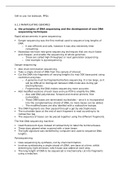Still to use: fat textbook, PPQs
6.1.3 MANIPULATING GENOMES
a. the principles of DNA sequencing and the development of new DNA
sequencing techniques
Rapid advancements in gene sequencing:
Sanger sequencing was the first method used to sequence long lengths of
DNA.
o It was efficient and safe, however it was also extremely time-
consuming.
Nowadays we have new gene sequencing techniques that are much faster
and cheaper, and enable the sequencing of whole genomes.
o These are called high-throughput or next generation sequencing.
o One example is pyrosequencing.
Sanger sequencing:
AKA chain termination sequencing.
Take a single strand of DNA from the sample of interest.
Cut the DNA into fragments of varying lengths (to max 500 base pairs) using
restriction enzymes.
o A genome must be fragmented before sequencing. It is too large, so it
will be difficult to distinguish between DNA molecules during gel
electrophoresis.
o Fragmenting the DNA makes sequencing more accurate.
Add modified versions of each base and use PCR to amplify the DNA.
o Also add DNA polymerase, forward and reverse primers, free
nucleotides.
o These DNA bases are terminated nucleotides – once it is incorporated
into the complementary strand of DNA, no more bases can be added.
o The modified bases are also labelled with a radioactive isotope.
The DNA fragments are then passed through a gel by electrophoresis.
The nucleotide base at the end of each fragment is read according to its
radioactive tag.
The sequence of bases can be pieced together using the different fragments.
The first DNA sequencing machine:
Used fluorescent dyes instead of radioactivity to label the terminal bases.
These dyes glowed when scanned with a laser beam.
The light signature was identified by computer and used to sequence DNA
lengths.
Pyrosequencing:
Uses sequencing by synthesis, not by chain termination.
Involves synthesising a single strand of cDNA, one base at a time, whilst
detecting by light emission, which base was added at each step.
The long length of DNA to be sequenced is mechanically cut into fragments
using a nebuliser.
, These fragments are degraded into single-stranded DNA (ssDNA).
The ssDNA fragments are immobilised on microbeads.
The sequencing primer is added and the DNA is incubated with DNA
polymerase, ATP sulfurylase, luciferase, apyrase, adenosine 5’ phosphosulfate
(APS) and luciferin.
o Enzymes: DNA polymerase, ATP sulfurylase, luciferase, apyrase.
o Substrates: adenosine 5’ phosphosulfate (APS), luciferin.
One of the four possible activated nucleotides (ATP, TTP, CTP, GTP) is added.
If the activated nucleotide is complementary to the ssDNA, it will be
incorporated into the cDNA.
o Two extra phosphate groups are released as pyrophosphate (PP i).
o In the presence of APS, ATP sulfurylase converts PP i to ATP.
o In the presence of ATP, luciferase converts luciferin to oxyluciferin.
This generates visible light, which is detected by a camera.
The amount of light generated is proportional to the amount of ATP available.
o Thus, it indicates how many of the same type of activated nucleotide
were incorporated adjacently into the cDNA strand.
Each activated nucleotide generates a different colour of light.
o This enables the computer to read the base sequence of the DNA
fragments.
Unincorporated activated nucleotides are degraded by apyrase.
The process is repeated using the other activated nucleotide bases until the
entire fragment is sequenced.
More info about restriction endonuclease enzymes:
Cut DNA at specific recognition sites (4 to 6 base pairs long).
Made by bacteria and archaea to protect against phage virus attack.
o Cut up the foreign viral DNA to prevent the virus from making copies.
o The prokaryotic DNA is protected from the action of these
endonucleases by being methylated at the recognition sites.
The recognition sites are always palindromic (e.g AGGCCT).
o Both strands have the same base sequence when read in the 5’ to 3’
direction.
Some make a staggered cut, leaving sticky ends.
Others make a straight cut, leaving blunt ends.
Some need Mg2+ as cofactors.
b. i. how gene sequencing has allowed for genome-wide comparisons
between individuals and between species
Bioinformatics and computational biology:
Involves developing software and computing tools to organise and analyse
the raw data.
Compare the gene sequences between individuals.
o Identify genotype-phenotype relationships.
o Detect SNPs which make people more susceptible to diseases.
o Epigenetics (mapping DNA methylation) can be used to determine the
development of certain diseases, e.g. some cancers.
o Epidemiology – analysing the gene sequence of pathogens.





